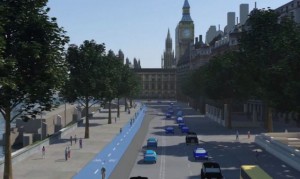 Londoners have always had a genius for urban transportation: faced with a massive population and crowded streets, the city built the world’s first subways (inaugurated in 1863). They also improvised double-decker buses—first powered by horse, then by motor—as a way to get twice as many people moving along the same square footage of roadway.
Londoners have always had a genius for urban transportation: faced with a massive population and crowded streets, the city built the world’s first subways (inaugurated in 1863). They also improvised double-decker buses—first powered by horse, then by motor—as a way to get twice as many people moving along the same square footage of roadway.
And now the Brits are showing their street smarts once again. Boris Johnson, London’s ebullient mayor, has seen the future, and the only way it works is if more people get out of their cars and bike to work and shop. Make that even more people: bicycle traffic in his city has already increased by more than 150 percent over the past decade, but that’s not enough. Johnson wants to see a 400 percent increase by 2025.
To make that happen, London is about to invest over $1.5 billion in new biking infrastructure: segregated blue lanes, signage, intersection improvements (including safety mirrors that let truck drivers see who’s in the blind spot), and bike parking facilities. The plan also includes a 15-mile continuous “quietway” for bikers that will run from east to west London.
Johnson isn’t just painting blue lanes on the pavement (though that seems to be what a lot of this). He’s also pushing for a revolution in biking culture: “I want to de-Lycrafy cycling. I want to make it normal, something for everyone, something you feel comfortable doing in your ordinary clothes.”
He’s also outspoken that this effort to make the bicycle more every day, more common man, more…pedestrian…has benefits for non-bikers as well: “Helping cycling will not just help cyclists. It will create better places for everyone. It means less traffic, more trees, more places to sit and eat a sandwich. It means more seats on the Tube, less competition for a parking place and fewer cars in front of yours at the lights.”
The city doesn’t need to transform transportation to see a big lifestyle improvement. Johnson claims that if a modest number of commuters, just 14 percent, can be convinced to bike to work, some key pollutants will be cut by a third “and over the years literally thousands of lives could be saved.”









